Total Emission of GHG
Emission of GHG in 2011 across the DOWA group was 1,380,000 tons (1,354,000 t in Japan and 26,000 t abroad), which was an increase of 2% compared to the previous year. Our main efforts in 2011 are as stated below:
Measures to reduce the amount consumed
![]() Change the refrigerant of A/C to non-CFC contained type refrigerant
Change the refrigerant of A/C to non-CFC contained type refrigerant
Measures for Reduction
![]() Implementation of inverter control of high voltage motors
Implementation of inverter control of high voltage motors
![]() Upgrading of boilers for air conditioning
Upgrading of boilers for air conditioning
![]() Installation of heat insulating materials for sintering furnaces
Installation of heat insulating materials for sintering furnaces
![]() Introduction of LED lighting and LED airplane warning lights
Introduction of LED lighting and LED airplane warning lights
![]() Reduction of power consumption by reducing the number of compressors
Reduction of power consumption by reducing the number of compressors
![]() Modified layout to better take daylight in, checking of unnecessary lighting and proper air conditioning and ventilation
Modified layout to better take daylight in, checking of unnecessary lighting and proper air conditioning and ventilation
Measures for CO2 from Transportation
![]() Modal shift between Akita area and West Japan
Modal shift between Akita area and West Japan
![]() Reduction of forklift operation by modifying layout inside our business establishments
Reduction of forklift operation by modifying layout inside our business establishments
Efforts for Carbon Offset
![]() Use of uniforms and forklifts targeted for carbon offset (contribution to reducing CO2 emission by approximately 8 tons)
Use of uniforms and forklifts targeted for carbon offset (contribution to reducing CO2 emission by approximately 8 tons)
< Changes of Annual Emission of Global Warming Gases
(Those derived from wastes are only in Japan) >
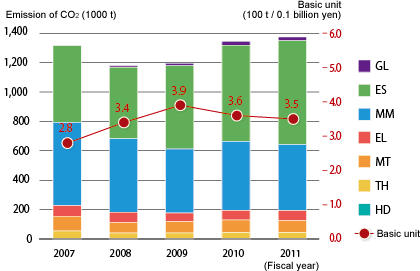
< Derived from Power + Fuel >
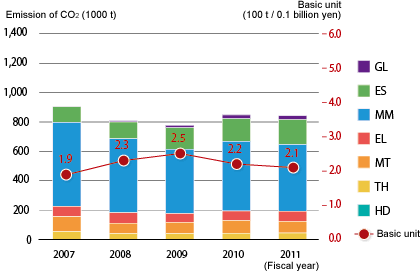
< Derived from Wastes (in Japan only) >
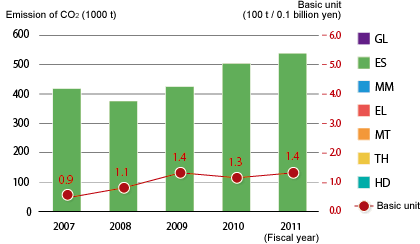
Other emissions (Greenhouse gas)
The CO2 emission derived from GHG in 2011 was 20,150 kg–CO2. The emission is attributable to application of 16 kg of HFC-134a. Although this amounted to only 0.001% of the entire GHG emission of the DOWA group, we continue suitable management for global warming mitigation.
Discharged Water
Quantity of discharged water in 2011 was about 101 million m3 (101 million m3 in Japan and 0.4 million m3 abroad). In connection with recovery of production from the earthquake in our Nonferrous Metals business that uses plenty of water, the quantity of the discharged water across the entire group increased by 4% from the previous year. This was partly because some of our business establishments were affected by the increase of rainfall, as rainwater on the premises of our business establishments was included in the amount of the discharged water.
Measures for Reduction
![]() Reuse of discharged water from processes
Reuse of discharged water from processes
< Changes of Annual Discharged Water >
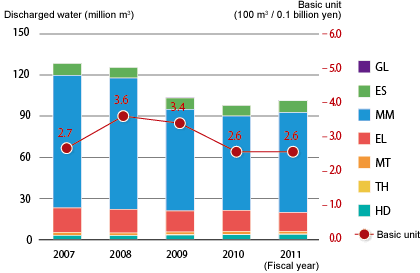
Burden of Air and Water Pollution
Composition of wastes accepted by our environment and recycling business significantly affects the changes of air and water pollution loads of the DOWA group. Each of our business establishments is committed to reduce these loads by enhancing their management system and setting forth its own standard that is stricter than those of governmental regulations.
[Exhaust gas]
Exhaust gas emission in 2011 was 8,725 million m3 (8,376 million m3 in Japan and 349 million m3 abroad) and the exhaust gas emission in Japan increased 9% compared to the previous year. Emission of nitrogen oxide (NOx) in Japan decreased by 7%, sulfur oxide (SOx) by 78% and ash dust by 6% compared to the previous year. The increase of emission of SOx was due to the influence of composition of accepted wastes, and the total emission of SOx of the DOWA group excluding the waste disposal business remained almost the same as the previous year.
[Water Quality]
BOD (biochemical oxygen demand) increased by 6% and COD (chemical oxygen demand) decreased slightly from the previous year.
DOWA Hightech has effluent treatment facilities called "Bio Pallette" utilizing vegetation. BOD there decreased by 25% from the previous year, while BOD in Kosaka Smelting & Refining increased by 21%, as it accepted 15% more wastes as raw material from the previous year. COD decreased by 7%in Akita Smelting & Refining.
Measures for Reduction
![]() Proper operational management of waste disposal facilities
Proper operational management of waste disposal facilities
![]() Increased efficiency of reduction of ash dust and other wastes
Increased efficiency of reduction of ash dust and other wastes
< Changes of Annual Wastes Produced >
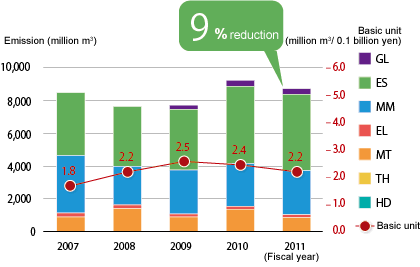
< Changes of Air Emission of per Substance >
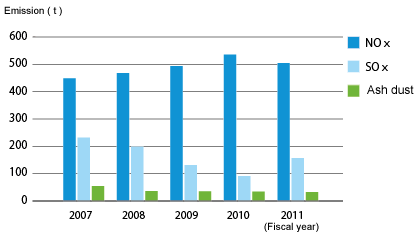
< Changes of Waste Water Discharge into Water Area per Substance >
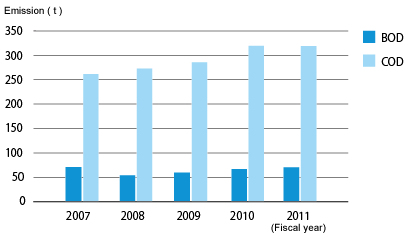
Quantity of Disposed and Transferred Chemical Substances
The DOWA group is committed to using and controlling chemical substances properly.
Measures for Reduction
![]() Recovery and reuse of chemical agents used in processes
Recovery and reuse of chemical agents used in processes
![]() Development of products that substitute for or that do not use hazardous substances
Development of products that substitute for or that do not use hazardous substances
Unit: (g-TEQ for dioxine)
| Cabinet order no. | Name of Class I chemical substances | Discharged amount | Transferred amount | ||||
|---|---|---|---|---|---|---|---|
| Atmosphere | Water area | Soil | Landfill within our own property | Sewage system | Outside of each business establishment | ||
| 1 | Water-soluble compounds of zinc | - | 5.2 |
- | - | - | - |
| 31 | Antimony and its compounds | 0.05 | 0.33 | - | 103 | - | - |
| 44 |
Indium and its compounds | - | - | - | - | - | 6.1 |
| 53 | Ethyl benzene | 0.03 | - | - | - | - | 2.9 |
| 72 | Ferric chloride | - | 0.01 | - | - | - | 117 |
| 75 | Cadmium and its compounds | 0.01 | 0.09 | - | 87 | - | 0.50 |
| 80 | Xylene | 0.03 | - | - | - | - | 3.1 |
| 82 | Silver and its water-soluble compounds | 0.01 | - | - | 5.7 | - | - |
| 87 | Chrome and trivalent chrome compound | - | 0.07 | - | 151 | - | 2.1 |
| 132 | Cobalt and its compounds | - | - | - | - | - | 2.5 |
| 144 | Inorganic cyanogen compounds (excluding complex salt and cyanic acid) | - | - | - | - | - | 0.01 |
| 237 | Mercury and its compounds | - | - | - | 0.74 | - | - |
| 242 | Selenium and its compounds | 0.02 | 0.18 | - | 8.1 | - | - |
| 243 | Dioxine | 0.14 | 0.001 | - | 0.31 | - | 25 |
| 258 | 1, 3, 5 and 7 - tetraazatricyclo [3.3.1.1.(3, 7)] decane | - | 0.12 | - | - | - | 567 |
| 272 | Water-soluble salt of copper (excluding complex salts) | - | 1.4 | - | - | - | 6.3 |
| 304 | Lead | 0.16 | 0.07 | - | 1,400 | - | 71 |
| 305 | Lead compounds | - | - | - | - | - | 354 |
| 308 | Nickel | - | 0.01 | - | - | - | - |
| 309 | Nickel compounds | - | 0.01 | - | - | - | 0.33 |
| 332 | Arsenic and its inorganic compounds | 0.22 | 0.06 | - | 630 | - | 3.6 |
| 333 | Hydrazine | - | - | - | - | - | 3.5 |
| 374 | Hydrogen fluoride and its water-soluble salt | 0.52 | 41 | - | - | - | - |
| 405 | Boron compounds | - | 12 | - | - | - | 1.3 |
| 412 | Manganese and its compounds | - | 8.6 | - | - | - | 320 |
Wastes Recycling that Occurred and Disposed
In 2011 total quantity of wastes that occurred was 1,399,000 tons (1,055,000 t in Japan and 344,000 t abroad), of which 715,000 tons were recycled and 684,000 tons were disposed. 43,000 tons out of recycled wastes were valuable resources. Wastes recycling that occurred in Japan decreased by 5% compared to the previous year mainly due to decrease of soil treatment.
Wastes treated in and outside of the DOWA group combined with wastes recycled outside of the group totaled to 844,000 tons (508,000 t in Japan and 336, 000 t abroad). Wastes recycled both in Japan and abroad were 159,000 tons. Wastes disposed in Japan decreased by 6% compared to the previous year. We had no wastes that were subject to the Construction Waste Recycling Law of 2011.
Measures for Reduction
![]() 70% reduction of disposal of used plastics through careful segregation compared to 2009.
70% reduction of disposal of used plastics through careful segregation compared to 2009.
![]() 98% reduction of used oil requiring special controls by modifying processes compared to 2009
98% reduction of used oil requiring special controls by modifying processes compared to 2009
![]() 10% increase of waste disposal of waste alkali within the group
10% increase of waste disposal of waste alkali within the group
< Changes of Annual Wastes Produced >
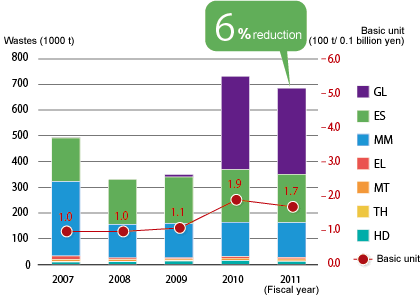
< Details of Disposed wastes >
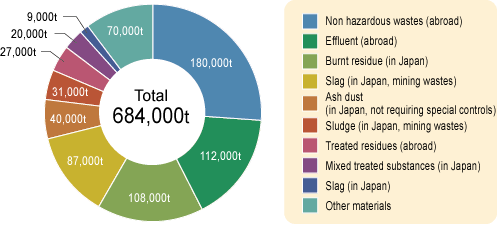
*Some corrections were made on wastes produced in previous years in our environment and recycling business (abroad).
Our policies to reduce packaging materials in 2011
![]() We optimize packaging method through wider use of large containers in order to reduce the use of packaging materials.
We optimize packaging method through wider use of large containers in order to reduce the use of packaging materials.
![]() We make every effort to promote reusing of containers and packaging materials by utilizing used flexible containers and returnable containers.
We make every effort to promote reusing of containers and packaging materials by utilizing used flexible containers and returnable containers.
![]() We coordinate with our suppliers in order to collect containers smoothly.
We coordinate with our suppliers in order to collect containers smoothly.
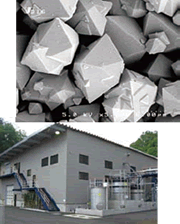
 Effective Utilization of Resources and Prevention of Environmental Pollution
Effective Utilization of Resources and Prevention of Environmental Pollution
We are now handling more ores that are difficult to process in connection with increased demand for metals and depletion of good mines. Excavated copper ores now have deteriorated quality and contain impurities such as arsenic is greater than in the past. It is an urgent issue for us to develop smelting and refining technologies that can extract metals efficiently and safely for treatment of impurities.
The DOWA Metals & Mining succeeded in practical use of the technology to produce a crystal called Scorodite. In this crystal form highly concentrated arsenic is not transferred from the intermediate substances that are produced in the copper smelting process. This process allows for effective extraction, safety segregation and detoxification of copper from ores of poor quality, resulting in effective utilization of unused resources and contributing to conservation of environment.
Conservation Status of Biodiversity

The DOWA group is committed to fostering the forests in Kosaka area in Akita Prefecture to be rich with biodiversity by afforestation to create forests full of diversity. We planted 8,600 trees together with local people in 2011, under the leadership of the Japanese Center for International Studies in Ecology led by Honorary Professor Akira Miyawaki at Yokohama National University, who is the leading researcher in plant ecology.

